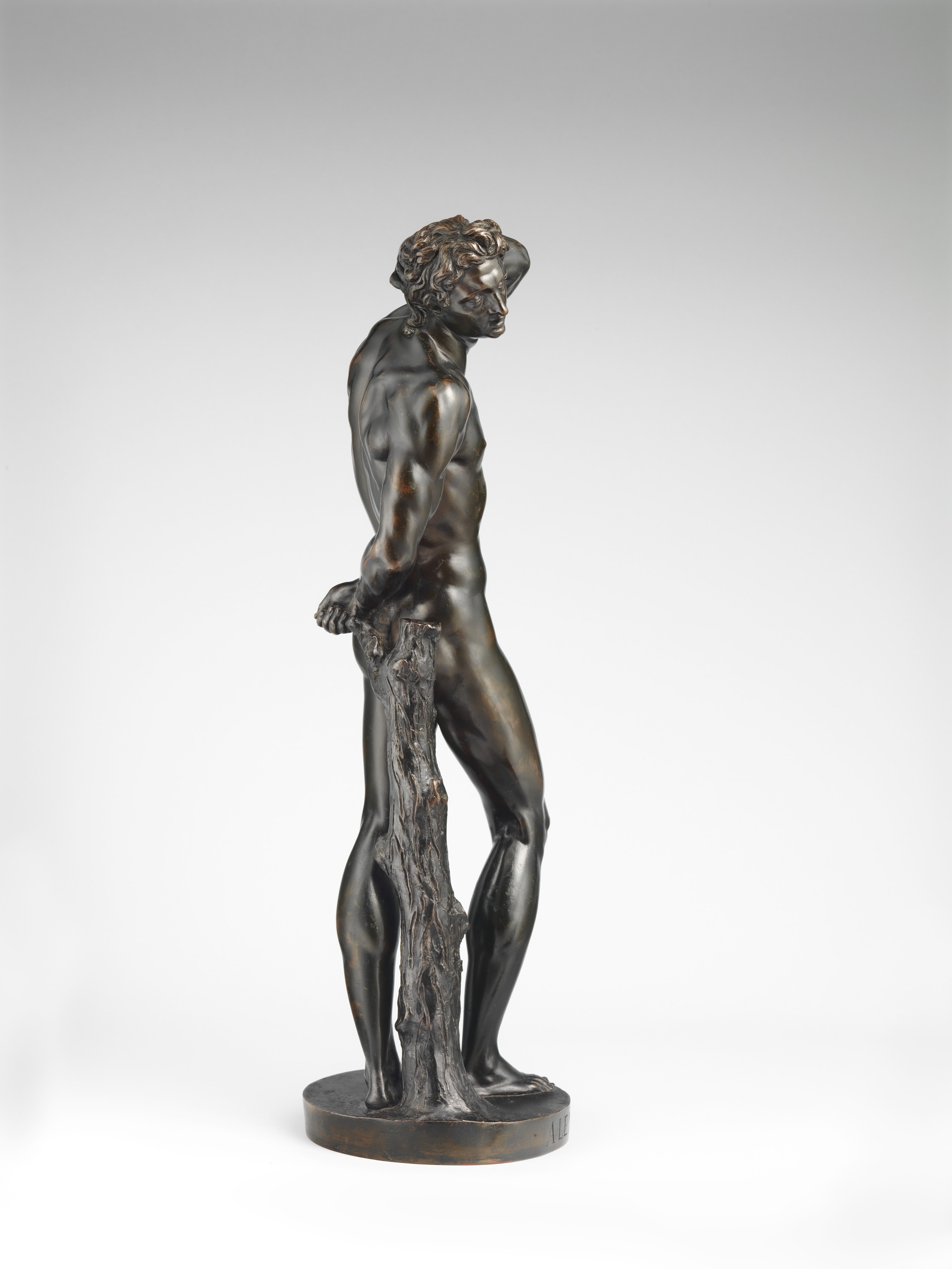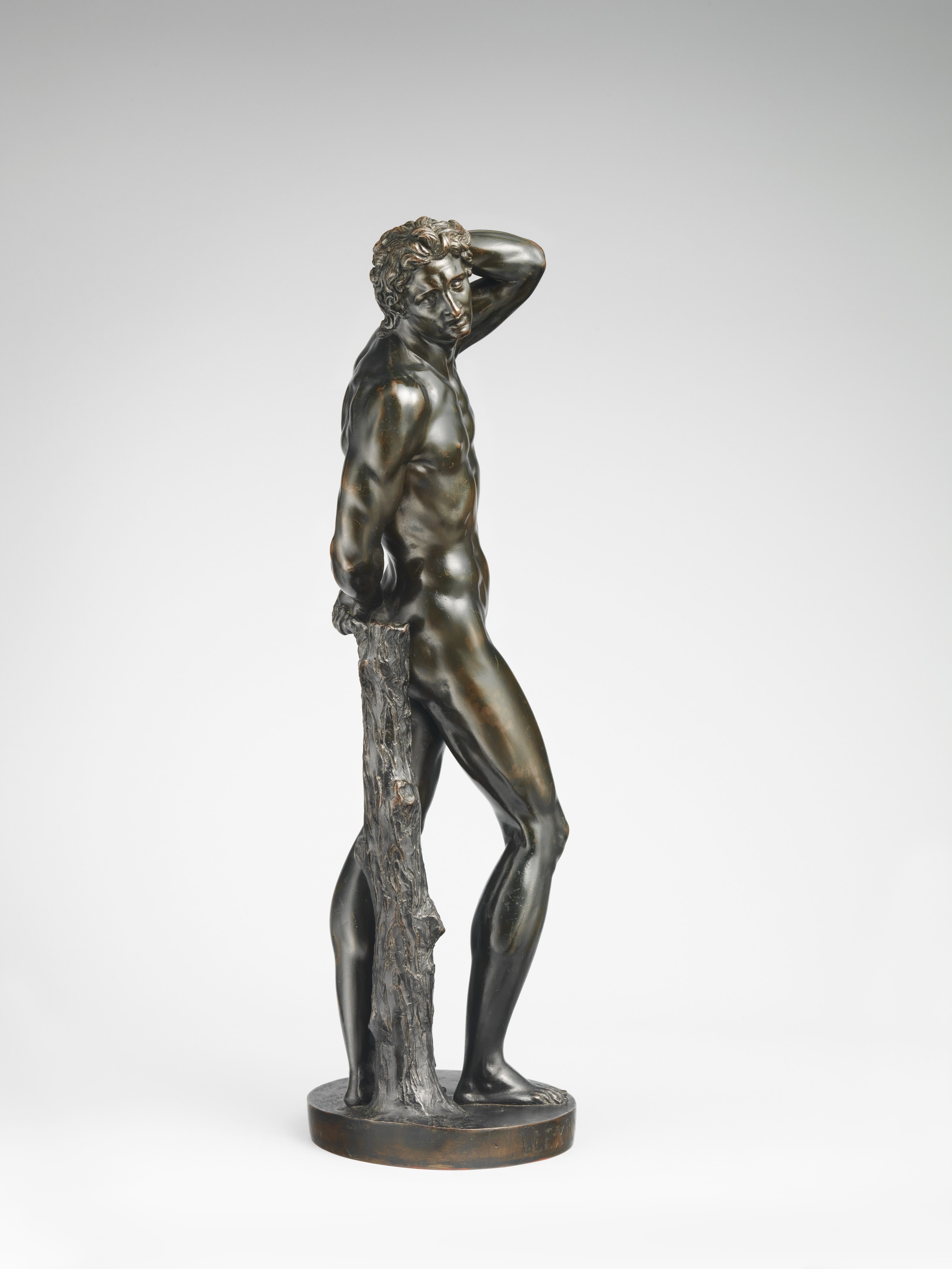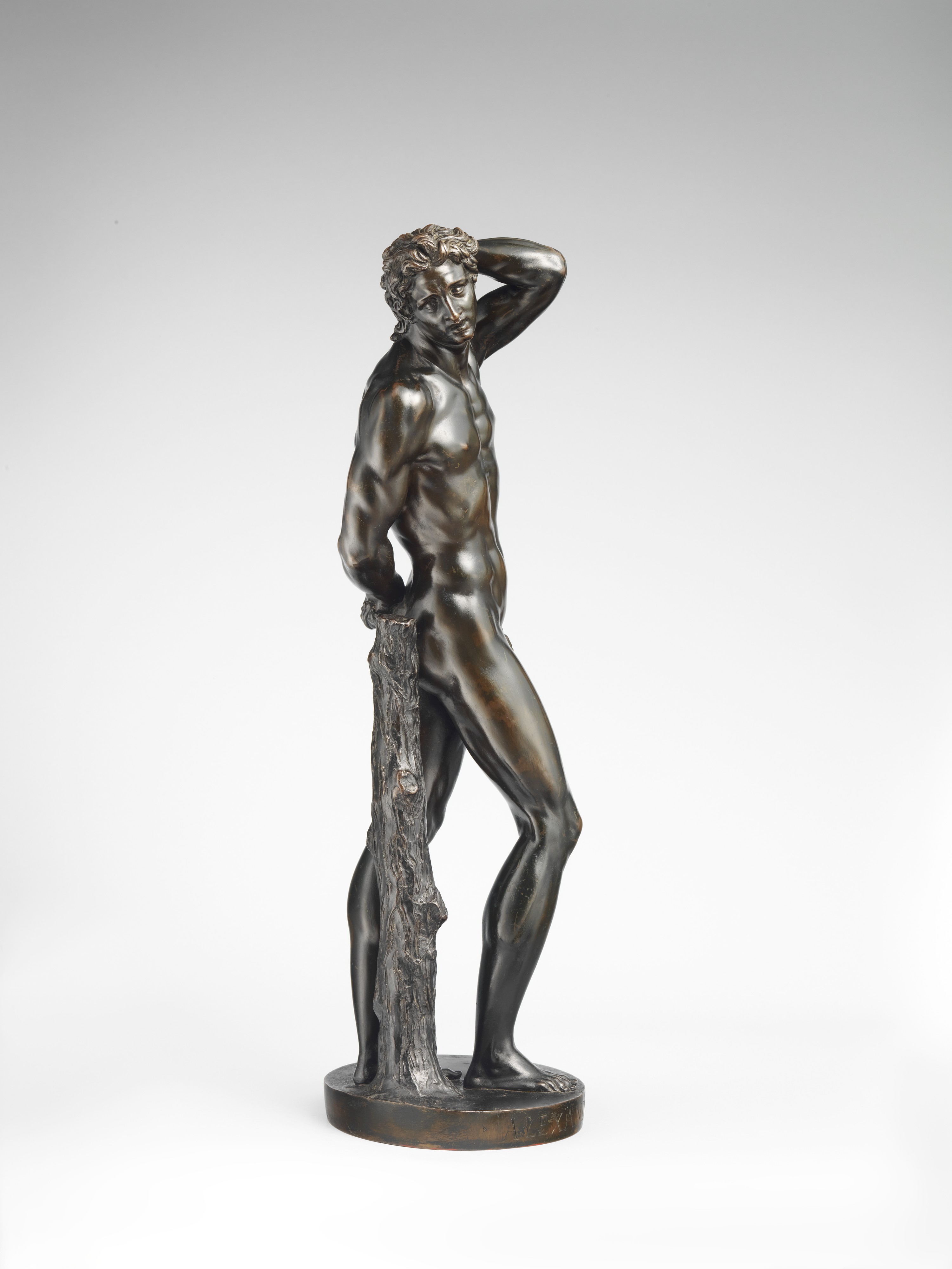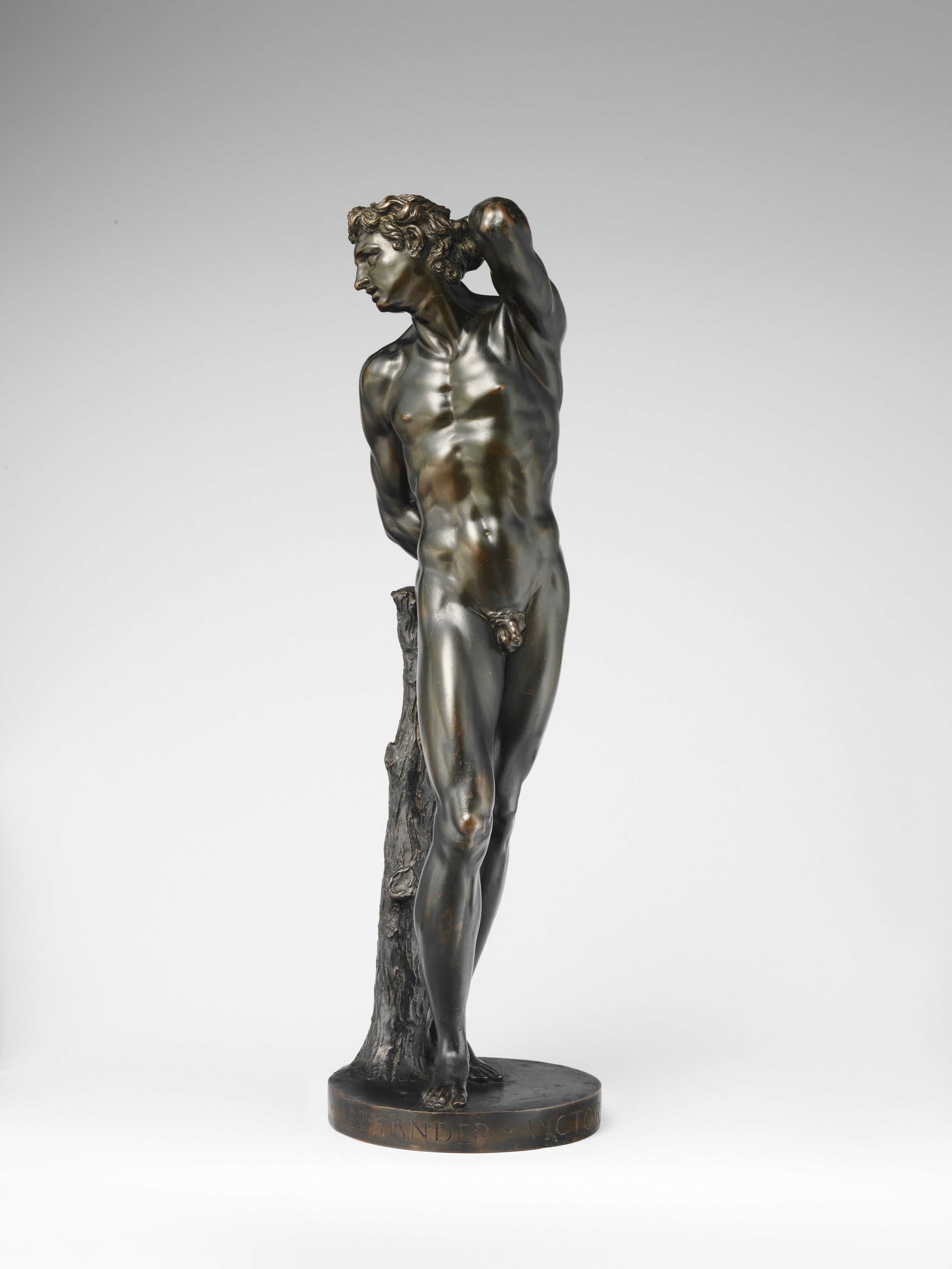Saint Sebastian
Alessandro Vittoria (Alessandro Vittoria di Vigilio della Volpa) Italian
Alessandro Vittoria, a pupil of Jacopo Sansovino, was the most important Venetian sculptor after his master’s death in 1570. He created monumental marble statues as well as sumptuous interior decorations in stucco and was an eminent portraitist. His rich oeuvre also includes bronze statuettes, which are usually a bit larger than the typical Renaissance bronzetto. Today, thirteen such bronzes, including The Met’s Saint Sebastian, all fully signed by the artist, are known, while another ten without signature are more or less convincingly attributed to him.[1] Seven of the signed bronzes depict pagan gods and were probably intended for private collectors, while six have religious subjects. Two of the latter, a Saint John and a Saint Francis, surmounted the holy water stoups in San Francesco della Vigna, Venice;[2] another two, the prophets Malachias and Melchizedek, once decorated the tabernacle of Santa Maria Gloriosa dei Frari, Venice.[3] Our Saint Sebastian, as well as another cast of the same model in a private collection,[4] never served a function[5] but remained in Vittoria’s own possession and were given special attention in his several wills. The fact that Veronese’s portrait of Alessandro Vittoria, also in The Met (fig. 58a), shows the sculptor tenderly holding a model of the statuette provides further evidence of the importance he assigned to this composition, which indeed represents one of his most ingenious and successful inventions.[6]
The striking pose of the tormented but beautiful nude youth, who leans against a truncated tree and bends his left arm back behind his head, was first formulated by Vittoria in a lifesize statue of Istrian stone executed in 1563–64 for the Montefeltro Altar in San Francesco della Vigna (fig. 58b).[7] On December 14, 1566, Vittoria made a final payment to Andrea di Alessandri, called Bresciano, for the casting of a Saint Sebastian in bronze.[8] Some eight years later, on May 16, 1575, the son-in-law of the deceased Bresciano, Orazio, was paid for the casting of another Saint Sebastian.[9]
Thus documentation confirms the production of at least two casts of Vittoria’s Sebastian during his lifetime, and until recently these statuettes were identified as the bronze in The Met and another, without signature but with a suspicious cache-sexe, in the Los Angeles County Museum of Art.[10] However, it is now agreed that the latter’s slack modeling and thin walls indicate a later cast, probably from the eighteenth century.[11] The appearance of a Sebastian on the art market in 1998[12] spurred a thorough reevaluation of the known statuettes and their relationship to the documents. The Met’s Saint Sebastian is now unanimously considered the cast executed in 1566 by Bresciano,[13] a highly skilled bronze founder who created, among other works, the monumental Paschal Candelabrum in Santa Maria della Salute in Venice.[14] Supporting this identification is the exceptional quality of the cast, which preserves every detail of what must have been a consummate wax model so that hardly any chasing was necessary. This corresponds perfectly with Vittoria’s remark that he gave to Bresciano a “well-cleaned wax.”[15] The very fine cast now in a private collection appears to be the one executed in 1575 by Bresciano’s son-in-law, who apparently had inherited Andrea’s workshop. This replica was clearly made from the same mold as our Sebastian but is not as sophisticated in its filing and finishing.
The subtle but crucial difference between the two figures is the signature. As observed by Richard Stone, our statuette features a signature that had been engraved in the wax model and then carefully but sparingly accentuated in the cold work, creating the crisp effect of an inscription carved in marble.[16] The signature on the privately owned Sebastian—ALEXANDER. VICTORIA. F[ECIT]—is less precise, almost sloppy, and omits the letter “T,” a reference to Vittoria’s native city Trent. As pointed out by Manfred Leithe-Jasper,[17] the denomination “tridentinus” and the abbreviated form of his surname were used by Vittoria only in his early works, further evidence that the present Saint Sebastian is indeed the cast documented in 1566.
If these assumptions are correct, it must have been these two figures that Vittoria mentioned in his fifth will of May 1586, in which he stated that only one of them was signed.[18] According to his wording in this document, one of the two statuettes had the signature “cut” into the base. Since the signature of The Met’s Sebastian is cast-in as well as chased, this description presents no conflict. It might explain, however, the slight awkwardness of the signature on the privately owned Sebastian, which was probably added only after Vittoria’s fifth will. Given the artist’s obsession with signing his works,[19] it would have been odd that a statuette he clearly valued very highly was left unsigned. It seems therefore conceivable that he rectified the oversight once he noticed it but that by that point his collaborators could not achieve the same crispness in the lettering.
References to Vittoria’s Saint Sebastian turn up repeatedly in the seventeenth century. In 1615, Vincenzo Scamozzi reported that the Venetian collector Bartolomeo della Nave owned one of the Sebastians, and according to an inventory of 1650 another was owned by the collector Girolamo Gualdo in Vicenza.[20] In addition to the two bronzes, plaster casts of Vittoria’s Sebastian must have been readily available and valued as workshop props. As such, they feature in paintings by Jan Steen, Gabriël Metsu, Evaristo Baschenis, and others.[21]
If one compares Vittoria’s bronze Sebastian with his stone sculpture for the Montefeltro Altar, it is quite remarkable how much the interpretation changed within two years. Although the pose remained the same, the proportions of the bronze are quite different. Legs and torso have been elongated considerably, as if the malleability of the material seduced Vittoria into stretching the figure to its limits. The bronze body is slenderer, smoother, and more fluidly modeled, emphasizing the grace of its dynamic twist. Even the stump is longer and thinner than the massive piece of tree behind the stone Sebastian. That such a device appears in the statuette at all may be considered strange, since bronze sculptures generally do not require such supports. But in this case, it is clear that the stump stabilizes the composition, allowing the complicated pose to play against it.
Several prototypes have been noted as inspiration for Vittoria’s Saint Sebastian: Michelangelo’s Dying Slave, the Laocoön, and the so-called Dying Alexander, the latter as the model for the Sebastian’s expressive head.[22] It is not surprising, then, that Lorenzo Finocchi Ghersi concluded that the Sebastian marks a turning point in Vittoria’s work, when the sculptor abandoned the style of his master Sansovino and fully embraced Michelangelo together with classical sculpture.[23] However, as observed with much insight by Hans Weihrauch, Vittoria’s affinity with Parmigianino was stronger than with Michelangelo, which is why he adapted the pose of the Dying Slave but not its powerfully modeled anatomy. In this regard, Victoria Avery has pointed to a drawing by Parmigianino of a nude man (fig. 58c), today in a private collection but once owned by Vittoria himself, that constitutes such an exact representation of the Saint Sebastian that one probably should see in it the most pertinent foretype for the sculpture.[24]
Vittoria’s Saint Sebastian came into being as a lifesize sculpture in stone that was intended for an altar niche. It might well be that Vittoria felt that his twisting, figura serpentinata–like invention was struggling in this setting against the confinements of the surrounding architecture. This and the experience of having successfully turned his stone Mercury for the finestrone of the Palazzo Ducale in Venice into a bronze statuette may have inspired him to do the same with the Sebastian.[25] In this medium, the composition could be seen from different angles, and he could explore a more mannered, or “Parmigianesque,” way of modeling the figure. Vittoria’s contribution to Michelangelo’s theme of the Slaves—basically exercises in displaying beautiful male bodies in distress—could thus be given a more personal interpretation.
Vittoria’s profound identification with this sculpture is demonstrated by Veronese’s portrait of the artist in which his right hand holds the model of Sebastian exactly where his signature appears on the bronze statuette. This hand—that of the artist and creator—is rendered very similarly to how Parmigianino had painted his own hand in the famous Self-Portrait in a Convex Mirror, which Vittoria had bought in 1561.[26] The Met’s Sebastian can thus be considered the “signature piece” by and of Alessandro Vittoria.
-CKG
Footnotes
(For key to shortened references see bibliography in Allen, Italian Renaissance and Baroque Bronzes in The Metropolitan Museum of Art. NY: The Metropolitan Museum of Art, 2022.)
1. See Leithe-Jasper in Bacchi et al. 1999, pp. 325–29.
2. They were stolen toward the end of the twentieth century.
3. The two prophets, once in the Feist collection in Berlin, were lost in World War II; see Leithe-Jasper in Bacchi et al. 1999, p. 325, with further references.
4. Christie’s, London, European Sculpture, July 7, 1998, lot 109.
5. At a height of 110 cm, the Mourning Virgin and Saint John, today in the Santi Giovanni e Paolo, Venice, but originally made for an altar in the Oratory of the Assunta and San Jerome at San Fantin, are perhaps too large to be considered statuettes but are mentioned here for completeness and to underline that Vittoria’s religious bronzes were usually intended for a specific function in a church.
6. Bayer 2005, pp. 20, 23.
7. See Sandro Sponza’s entry on the altar in Bacchi et al. 1999, pp. 314–18, cat. 66.
8. V. Avery 1999b, doc. 61; see also Predelli 1908, p. 132.
9. V. Avery 1999b, doc. 91; see also Predelli 1908, pp. 135–36.
10. The confusion had mostly to do with Vittoria stating in his third will of November 7, 1570 (see Gerola 1924–25, pp. 348–49; V. Avery 1999b, doc. 77), that the bronze statuette—at this time there apparently existed only one cast—could be interpreted as either Sebastian or Marsyas. Given the cache-sexe of the figure in Los Angeles (M.51.12), one could argue that a saint should be depicted with a drapery covering his groin, while a satyr could be entirely nude (see, for instance, Leithe-Jasper in Krahn 1995, p. 298, cat. 83). However, Vittoria differentiates the two subjects not by the use of drapery, but by the suggestion of a wound below the left breast, which makes the entire argument moot. Like Giambologna in Florence, Vittoria showed thus the same indifference to subject matter that was made popular by Michelangelo.
11. Schaefer and Fusco 1987, p. 170.
12. See note 4.
13. Leithe-Jasper in Bacchi et al. 1999, pp. 342–45.
14. Davis 1976, p. 163. On Bresciano in general, see C. Avery 2020.
15. V. Avery 1999b, doc. 91; see also Predelli 1908, pp. 135–36.
16. R. Stone/TR, July 7, 2009. The statuette was thinly and evenly cast in a quaternary alloy of copper, zinc, lead, and tin, with trace impurities.
17. Bacchi et al. 1999, p. 344.
18. Gerola 1924–25, p. 353; V. Avery 1999b, doc. 121. Again, Vittoria’s comment in his third will that the bronze could be interpreted as depicting Sebastian or Marsyas (see note 10), explains why the mention of a “marsia” in his fifth will is likely to refer to his beloved Saint Sebastian. In the past, the distinction of one cast being signed and the other not has been seen as confirmation of the authenticity of the unsigned Sebastian in Los Angeles.
19. See V. Avery 2007a, pp. 20, 23.
20. Scamozzi 1615, vol. 1.3, p. 306; Gualdo 1972, p. 56.
21. For a detailed list, see Leithe-Jasper in Bacchi et al. 1999, p. 345.
22. Planiscig 1921, p. 452; Venturi 1935–37, vol. 3, p. 93; Valentiner 1942, p. 149.
23. Finocchi Ghersi 1998, p. 140; Finocchi Ghersi 2020, p. 29.
24. V. Avery 1999a, p. 147.
25. Getty, 85.SB.184. Peter Fusco (in Bacchi et al. 1999, p. 336, cat. 72) suggested that the bronze Mercury might have derived from an unexecuted model for the finestrone—its genesis is not yet entirely clear.
26. Kunsthistorisches Museum, GG 286; V. Avery 1999a, p. 143.
27. A photograph (ESDA/OF) shows Vittoria’s Saint Sebastian (undoubtedly our cast) standing next to the equestrian statuette of Teodoro Trivulzio that belonged to Gustav von Benda in Vienna (see Bode 1907–12, vol. 1, pl. LXXII). While the latter was part of the “Legat Benda” and entered the Kunsthistorisches Museum in 1930, the Saint Sebastian did not, so it must have been sold before.
28. New York 1927, pl. XLVI.
Due to rights restrictions, this image cannot be enlarged, viewed at full screen, or downloaded.
This artwork is meant to be viewed from right to left. Scroll left to view more.









